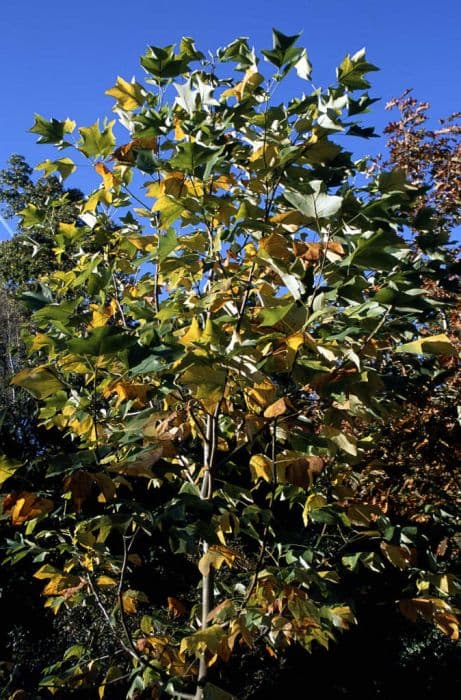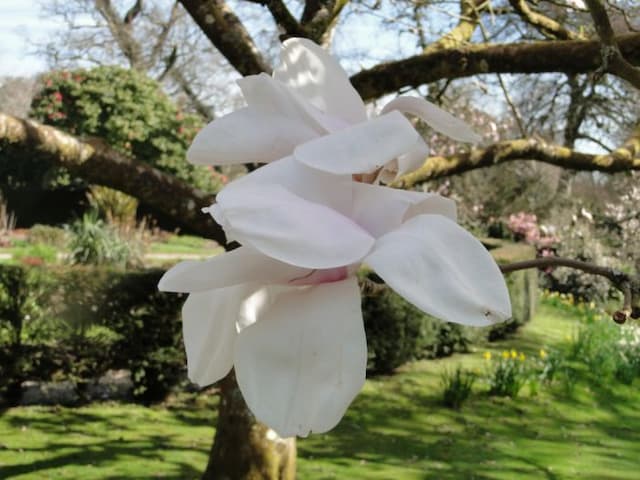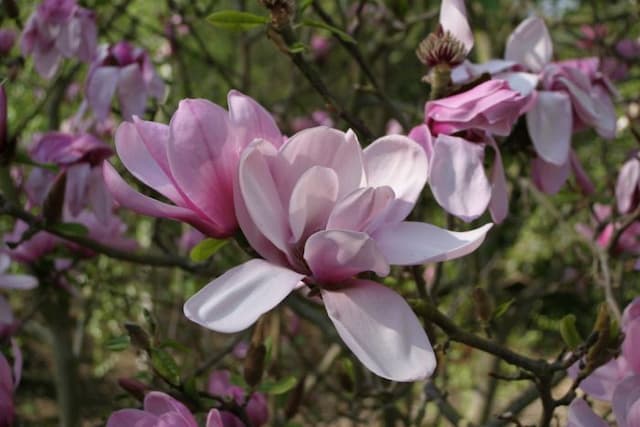Pink Magnolia Magnolia 'Pinkie'

ABOUT
Magnolia 'Pinkie' is known for its charming and distinctively beautiful flowers that boast a soft pink color. These blooms often emerge in a goblet shape before unfurling into a cup-like form, exuding gentle grace with their smooth petals that may sometimes display a lighter, nearly white interior. The outer side of the petals highlights a deeper pink tone, creating a delightful two-tone effect that is particularly striking amidst the lush foliage of the plant. The leaves of Magnolia 'Pinkie' are a rich, glossy green, adding a robust backdrop to the floral display. These leaves are leathery in texture, with an appearance that speaks to the hardiness of the plant. Together, the flowers and foliage offer a contrast in both color and texture, making this plant an eye-catching specimen throughout its blooming season. While the flowers are undoubtedly the star attraction, the overall form of Magnolia 'Pinkie' is noteworthy as well, with a shape that is typically balanced and symmetrical, lending a sense of harmony to garden settings. This plant's appeal only heightens as it matures and showcases its full splendor with an abundance of its characteristic pink blooms.
About this plant
 Names
NamesFamily
Magnoliaceae
Synonyms
Pinkie Magnolia, Pink Magnolia
Common names
Magnolia 'Pinkie'.
 Toxicity
ToxicityTo humans
Magnolias, including the 'Pinkie' variety, are not generally considered poisonous to humans. There is typically no worry for toxicity if a person ingests parts of this plant. However, as with any plant material, individual allergies or sensitivities could potentially cause mild stomach upset if ingested in large quantities.
To pets
Magnolias, such as the 'Pinkie' variety, are not commonly toxic to pets. They are considered to be of low toxicity, and ingestion of magnolia flowers or leaves may result in mild gastrointestinal upset in some pets, but they are not expected to be severely toxic or cause serious harm. If your pet does ingest magnolia and shows signs of distress, consult with a veterinarian.
 Characteristics
CharacteristicsLife cycle
Perennials
Foliage type
Deciduous
Color of leaves
Green
Flower color
Pink
Height
10-15 feet (3-4.5 meters)
Spread
6-10 feet (1.8-3 meters)
Plant type
Tree
Hardiness zones
7
Native area
Southeast Asia
Benefits
 General Benefits
General Benefits- Attractive Flowers: Magnolia 'Pinkie' boasts large, showy pink blooms that add aesthetic appeal to any garden.
- Fragrance: The flowers emit a pleasant fragrance that can create a relaxing and enjoyable outdoor atmosphere.
- Landscape Design: Its shape and size make it an excellent focal point or specimen tree in landscape design.
- Wildlife Attraction: The flowers can attract pollinators such as bees and butterflies, supporting local ecosystems.
- Shade Provider: As a moderately-sized tree, it can offer shade in gardens and outdoor living spaces.
- Seasonal Interest: Provides year-round interest with its flowers in spring, lush foliage in summer, and sometimes interesting seed pods in the fall.
- Low Maintenance: Requires minimal pruning and maintenance once established, making it suitable for many gardeners.
 Medical Properties
Medical Properties- Anti-inflammatory: Magnolia 'Pinkie' may contain compounds that can reduce inflammation in the body.
- Anxiolytic: Contains magnolol and honokiol, which have been suggested to possess anxiolytic effects.
- Antioxidant: The plant may have components with antioxidant properties that help combat oxidative stress.
- Antibacterial: Magnolia 'Pinkie' might carry substances that are effective against certain bacteria.
- Antifungal: May contain compounds with the ability to inhibit the growth of certain fungi.
- Antispasmodic: Potential to relieve spasms of muscles or to alleviate the symptoms of spasticity.
 Air-purifying Qualities
Air-purifying QualitiesThis plant is not specifically known for air purifying qualities.
 Other Uses
Other Uses- Art and Craft Material: Petals from Magnolia can be used in crafting, pressed flower art or can be crystallized and used in decorative purposes.
- Perfume Industry: Magnolia essential oil, extracted from the flowers, is sometimes used in the production of high-end perfumes.
- Culinary Uses: The flowers, which are edible, can be used as a delicate garnish for salads and desserts.
- Tanning Leather: The bark of the Magnolia tree contains tannins and can be used in the leather tanning process.
- Furniture Make: Wood from the Magnolia tree is used in cabinet making and for interior trim due to its durability and finish.
- Dye Production: The bark can be processed to make natural dyes for fabric or paper.
- Religious Symbolism: Magnolia flowers are used in religious ceremonies in some cultures due to their significance and beautiful appearance.
- Feng Shui: It is believed that placing Magnolia flowers in a home will bring about purity and peace, according to Feng Shui principles.
- Photography: Magnolias are often the subject of botanical photography due to their striking blooms and are used in photo arts and exhibitions.
- Literary Inspiration: Magnolia flowers have inspired poets and writers, often symbolizing nobility, perseverance, and love of nature in literature.
Interesting Facts
 Feng Shui
Feng ShuiThe Magnolia is not used in Feng Shui practice.
 Zodiac Sign Compitability
Zodiac Sign CompitabilityThe Magnolia is not used in astrology practice.
 Plant Symbolism
Plant Symbolism- Nobility: In ancient China, magnolias were thought to symbolize nobility and dignity, often associated with the refined beauty of emperors and kings.
- Purity: The magnolia's stunning white flowers can symbolize purity and innocence, conveying a message of clean and unblemished beauty.
- Perseverance: Magnolias are known for their hardy nature and ability to withstand harsh conditions, making them a symbol of strength and endurance.
- Femininity: With its delicate, soft petals, the magnolia is often related to femininity and beauty, representing the grace and gentleness often attributed to women.
- Love for Nature: The magnolia's close connection with the outdoors and its long-standing presence in natural landscapes reflect a deep appreciation and love for nature.
 Water
WaterPinkie Magnolias should be watered deeply and thoroughly, ensuring that water reaches the root zone. During the growing season, water the plant once a week with about 1 to 1.5 gallons, depending on the size and maturity of the plant. During hot dry spells, water twice a week, but always check the soil moisture first; it should be moist but not soggy. Reduce watering to every two to three weeks in the fall and winter when the plant is dormant.
 Light
LightPinkie Magnolias thrive in full sun to partial shade. The best spot would be one where the plant receives at least four to six hours of direct sunlight each day, complemented by some dappled shade in the afternoon to protect from intense heat, especially in hotter regions.
 Temperature
TemperaturePinkie Magnolias are hardy and can tolerate a range of temperatures. Ideally, they prefer a daytime temperature of about 70 to 85 degrees Fahrenheit and can withstand a minimum winter temperature down to around 0 degrees Fahrenheit. For optimal growth, avoid places where temperatures regularly drop below this threshold.
 Pruning
PruningPrune Pinkie Magnolias to maintain their shape and remove any dead or broken branches. The best time for pruning is late winter or early spring, just before new growth begins. Pruning can be done annually, focusing on thinning out crowded areas to allow light and air to reach the center of the tree.
 Cleaning
CleaningAs needed
 Soil
Soil'Pinkie' Magnolia prefers well-draining, rich soil with a slightly acidic to neutral pH, generally between 5.5 and 7.0. A mix composed of loamy garden soil, compost, and peat moss can provide the right structure and fertility. For container-grown plants, incorporating perlite or coarse sand improves drainage.
 Repotting
Repotting'Pinkie' Magnolia trees are slow-growing and do not require frequent repotting. Young plants can be repotted every 2-3 years; mature trees may be repotted less frequently, as needed when the root system outgrows the current container.
 Humidity & Misting
Humidity & Misting'Pinkie' Magnolia tolerates a wide range of humidity levels but thrives best in areas with moderate humidity. It does not require any special humidity adjustments when planted outdoors in its appropriate hardiness zones.
 Suitable locations
Suitable locationsIndoor
Provide bright, indirect light and consistent temperatures.
Outdoor
Plant in sun or part shade; protect from strong winds.
Hardiness zone
6-10 USDA
 Life cycle
Life cycleThe Magnolia 'Pinkie' begins its life cycle when a seed germinates in favorable soil and climate conditions, often in spring. It then enters a juvenile growth phase, rapidly establishing roots and producing its first shoots and leaves, which are initially tender and green. As the plant matures, it develops into a bushy shrub or small tree, with the foliage becoming denser and the woody structure more pronounced. The Magnolia 'Pinkie' reaches sexual maturity after several years, producing its first buds that bloom into large, fragrant pink flowers in early to late spring, depending on the climate. Following the flowering stage, if pollination occurs, the plant will produce cone-like fruit to disperse seeds which can lead to new plants, thus continuing the cycle. In the absence of environmental stresses, a Magnolia 'Pinkie' can go through multiple cycles of growth, flowering, and seed production, living several decades.
 Propogation
PropogationPropogation time
Spring-Early Summer
Propogation: The prime time for propagating a Magnolia 'Pinkie' is typically in the late spring or early summer when the plant is actively growing. A popular method of propagation for this type of magnolia is through softwood cuttings. This process involves taking a young cutting, about 4 to 6 inches (10 to 15 centimeters) in length, from new growth that is not yet firm. The leaves on the lower half of the cutting are removed, and the cut end is often dipped in a rooting hormone powder to encourage root development. After preparing the cutting, it is planted in a pot filled with a well-drained soil mix and kept under high humidity and indirect light until roots have formed, which may take several weeks. The pot should be kept moist but not waterlogged to foster root growth without causing rot. Once the cuttings have rooted and show new growth, they can be gradually transitioned to outdoor conditions if necessary.









![Magnolia [Felix Jury]](/_next/image?url=https%3A%2F%2Fplants-admin.emdemapps.com%2Fimages%2Fplants%2F%2Fimages%2F604b61a0b23b7.png&w=640&q=75)